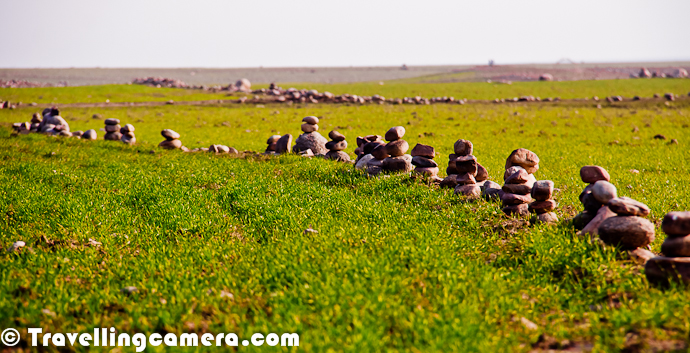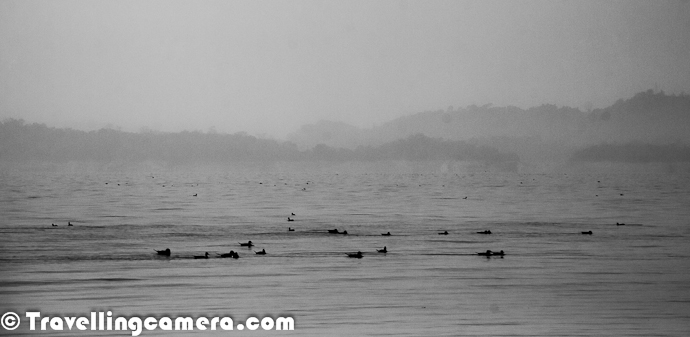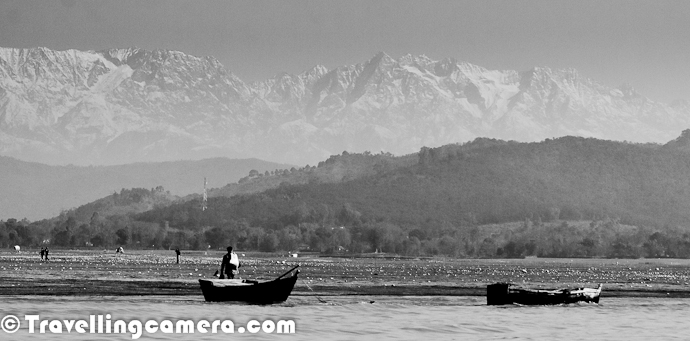Maharana Pratap Sagar aka Pong Dam Lake surrounded by Dhauladhar Mountain Ranges in Kangra Region of Himalayan State of India !!!
Recently I visited Pong Dam which is situated in Kangra Region of Himachal Pradesh. It was a wonderful experience with migratory birds from various wetlands across the world. Before talking about birds of Pong Water Reseroir, let's have a quick Photo Journey to this lake near Nagrota Suriyan and Meenu Khad !!!
Such green fields can be seen around Pong Lake.
I was eagerly waiting for my Pong trip for last one year. I had heard a lot about this place and migratory birds come to this place but never had a chance to witness it. Eagerly waiting for winters of 2011, one day I met one of the friends who told me about an annual bird counting event, when Himachal Wildlife Department also share some insights about the Birds and their eco-system. After finding more details I planned to visit Pong in January month of 2012...
Here is a photograph showing snow covered Dhauladhar Mountain peaks in the background of Pond dam with lot of boats parked on the shores. Fishing is another main business of localities and some of the very popular species of fishes are available in Pong Dam. Many times, fishermen curse the migratory birds that they eat the fishes but this is not exactly the fact which can be very well explained by conservators of this land. Overlooking Dhauladhar Himalayan ranges look amazing with bright blue water of Pong Water Reservoir.
During early morning and late evenings, some parts of this lake can be seen full of birds floating over the water surface. During this trip I got an opportunity to meet some of the passionate birders and Wildlife professionals. After meeting them and seeing birds from their POV, I am motivated enough to explore more about birds and visit such wetlands of India soon.
There are lot of agricultural land around the land which was acquired by government by paying appropriate amount to the owners but it's still in use by localities. This land is extremely good for agriculture and due to these migratory birds it also gets appropriate fertilizers apart from the fertilizers provided by lake water... But at the same time, farmers need to be regularly attentive to ensure that birds don't destroy the crop completely. Birds like Bar Headed Goose love to bite the green leaves and mainly dependent of such stuff. Since these birds come to this wetland in abundance, it becomes important to keep an eye on fields on daily basis. Above Photograph shows a small hut where farmers sit throughout the day to make sure that birds don't enter into the fields and car outside it.
Here is a Photograph of Pong Dam near Meenu Khad region, where Mr. Bhupinder Rana, DFO Kullu is watching Birds and trying to estimate the count of this region. During these two days of visit to Pong Dam, I met various people from Wildlife department of Himachal Pradesh, Chandigarh Birding Club and Delhi Birding Club. There were 21 teams of around 4-6 people in each to count birds in various parts of Pong Water Reservoir.
Fisherman going to the market after parking his boat at shoreline of Pong Dam. Snow covered Dhauladhar Mountain Ranges look amazing in the background of pong Dam.
Maharana Pratap Sagar in India, which is also known as Pong Reservoir or Pong Dam Lake was created in 1975, by building the highest earthfill dam in India on the Beas River in the wetland zone of the Siwalik Hills of the Kangra district of the state of Himachal Pradesh. Named in the honour of the patriot Maharana Pratap this reservoir or the lake is a well-known wildlife sanctuary and one of the 25 international wetland sites declared in India by the Ramsar Convention.
Lot of bird-watchers from various parts of the world come to this place for seeing Himalayan Birds and witness Migratory birds during winter season from October to March months of every year. Above Photograph shows some of the Birders from Chandigarh, Kullu and Chamba who are busy in enjoying various movements of birds during cloudy day at Pong Dam.
The Pong Reservoir and Gobindsagar Reservoir are the two most important fishing reservoirs in the Himalayan foothills of Himachal Pradesh. These reservoirs are the leading sources of fish within the Himalayan states.
Pong Dam Lake was declared a Ramsar Wetland site on account of its rich waterfowl diversity for conservation and sustainable use of the wetland. This recognition was based on a proposal formulated by the Himachal State Council for Science, Technology and Environment, Shimla submitted to the Ramsar Bureau, Switzerland through the Union Ministry of Environment and Forests of the Government of India.
The large reservoir and its strategic location in the extreme north-west of the northern plains has attracted migratory birds from the plains of India and Central Asian countries and Siberia. The interception of the migratory birds on their trans-Himalayan fly path, during each migration season, has enriched the biodiversity values of the reservoir.The Pong reservoir and its catchment have the following rich flora and fauna.
The large reservoir and its strategic location in the extreme north-west of the northern plains has attracted migratory birds from the plains of India and Central Asian countries and Siberia. The interception of the migratory birds on their trans-Himalayan fly path, during each migration season, has enriched the biodiversity values of the reservoir.The Pong reservoir and its catchment have the following rich flora and fauna.
After collecting some Memorable moments at Pong Dam, we shall continue with more Photo Journeys with various Birds, Birders and Conservators of this region. Keep watching this place for more...
Check out more about Pong at :-














.jpg)
Comments
It's a must go place, if you are around Dharmshala, Mcleodganj or Palampur during winters...